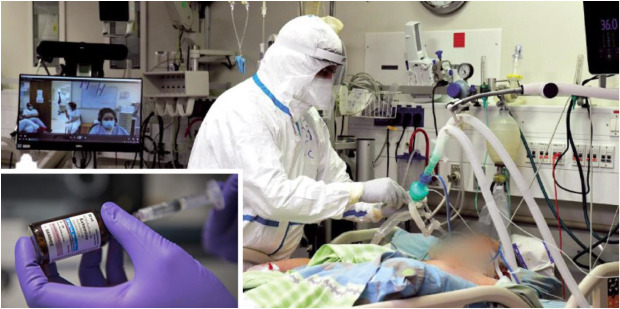1. Reduce the use of additive sedatives that propel the virus-induced immunological outburst.
2. Prevent sedative-induced deterioration and even improve respiration and oxygenation, both during spontaneous or assisted ventilation.
3. Minimize hemodynamic aberrations, including sepsis-like conditions.
4. Prevent deterioration and possibly ameliorate patient’s depressive state while allowing the maintenance of a comfortable and stable level of sedation or anesthesia.
1. As reported elsewhere, blood levels of interleukin-6 (IL-6) and C-reactive protein (CRP), which are two principle markers of coronavirus contagion, were detected lowered after ketamine administration, due to its anti-inflammatory capabilities.35 When an S-(+)-ketamine-based non-opioid multidrug protocol was compared to a sufentanil-based general anesthesia,6 the anti-inflammatory cytokine IL-10 levels increased 1 hour after aortic unclamping in the former. Pre- and post-operative plasma levels of tumor-necrosis factor-α (TNF-α) and TNF-α receptor 1 (TNF R1) remained stable, as did the CRP and leukocyte counts, in the ketamine group. Clinical and laboratory findings lend encouragement to the use of ketamine in the COVID-19 population in preference to opioids that are known for their pro-inflammatory activity and cardiovascular depression.7 Thus, when sedation is required in a COVID-19 patient, ketamine would appear to be superior to other sedative drugs due to its anti-inflammatory effects.
2. This author and his colleagues have repeatedly evaluated the effects of postoperative coadministration of small doses of ketamine vs. morphine on analgesia, fingertip pulse-measured (peripheral blood) oxygen saturation (SpO2), and subjectively rated variables.234 Patients who received a combination of ketamine and morphine exhibited increased respiratory rates immediately after this administration compared to morphine only, indicating more efficient mechanics and non-hypoxic respiration drive where ketamine was used. Fingertip oximetry (SpO2) was also maintained better in ketamine-treated individuals, with higher values than those measured before ketamine administration. Thirty minutes after ketamine injection, the patients' heart rate, blood pressure, and end-tidal (expiratory) carbon dioxide pressure (ETCO2) were similar to the preoperative values, while these parameters did not return to previous values until 60 minutes after morphine was administered.2 Importantly, unlike morphine, ketamine is known to induce bronchodilation and antagonize bronchospasm, allowing for easier breath mechanics. Noteworthy, hypersalivation and bronchorrhea were reported in the past when mega doses of ketamine were commonly administered; these are extremely rare nowadays that subanesthetic doses reign the protocols.2 Antiscialogue drugs are rarely required.
3. Sedation and anesthesia are key procedures in both light and seriously infected COVID-19 patients, both when requiring assisted as well as positive pressure ventilation. Compared to the effects of ketamine on respiration (see above), the effects of most sedatives and opioids on the respiratory and cardiovascular systems are depressant, i.e., they cause hypopnea, vasodilation, bradycardia, or tachycardia. This is especially true when remifentanil is administered conjointly, as occurring frequently intraoperatively (dose ranges 0.1–0.5–0.7 mcg/kg/min). The administration of opioids would be especially troublesome in coronavirus patients when exhibiting hypoxemia, dyspnea, persistent cough and hemodynamic instability. Ketamine is devoid of such untoward effects; it improves respiratory mechanics and exerts antagonistic effects in the presence of sepsis-like conditions, even during sedation. Indeed, unlike propofol or remifentanil, it may be used for long-standing sedation or anesthesia, increasing and maintaining blood pressure and heart rate by inducing the release of endogenous catecholamines.48 Upon the cessation of remifentanil or propofol infusions that may be co-administered in the COVID-19 patients, patients would wake up in confused and agitated states, and sometime writhe in pain.9 When stopped, or following down-dialing ketamine's rate, such reactions are extremely rare or nonexistent.34 Ketamine may also conceal remifentanil's hyperalgesic effect that commonly appears upon its termination;9 if given alone, ketamine does not generate such an after-effect. Ketamine would therefore suit patients who need either moderate or deep sedation or anesthesia, especially when remifentanil is added. Their coadministration reduces dose rates, while maintaining satisfactory levels of sedation.2
4. There are recognized concerns about patients' mental health during the pandemic. Preservation of patients' calm and positive state of mind during hospitalization needs therefore referring to; 1 month after discharge 10% of COVID-19 population reported depression and posttraumatic stress disorder, while 50% acknowledged depression during the treatment.10 Abrupt awakening from sedation is a frequent cause for disorientation and severe stress. The wearing off of the pharmacological effects of ketamine is slow and adjustable due to its long-acting metabolites. This allows return of a graduate and adjustable cognitive state at a controlled pace. Optimal calm recovery from ketamine sedation was reported in the elderly; animals subjected to a ketamine regimen demonstrated maintenance of cognition while reducing earlier behavioral depression. These findings may be especially relevant to patients who may express despair even before their admission to a special care ward.11 Indeed, recent reports have demonstrated that besides ketamine's efficacy in minimizing drug-resistance depression, it may also be an effective option for the treatment of suicidal ideation in inpatient, outpatient, or in emergent settings. Several studies found that depression and anxiety were relieved with no adverse effects in hospitalized patients who were given oral S(+)-ketamine for several weeks. Although R-ketamine and esketamine are not yet approved treatments for depression, their clinical use is worldwide known and applied in many medical centers. Thus, since loneliness, fear of helplessness, depression, and panic, frequently take possession of peoples' thoughts throughout an epidemic/pandemic, sedation with ketamine appears to have compelling advantages over other sedatives for COVID-19 inpatients.
• is an inexpensive, well-studied and safe drug
• bestows anti-pro-inflammatory capabilities
• is administered in an easy and dose adjustable manner
• provides optimal and smooth sedation and state of anesthesia
• stabilizes hemodynamic conditions
• does not depress automaticity and mechanics of the respiratory system and blood saturation
• is devoid of the physiological and psychological storms that frequently follow awakening from sedatives and anesthetic drugs
• provides anti-depressive effects and quietens suicidal thoughts,12




 PDF
PDF Citation
Citation Print
Print




 XML Download
XML Download